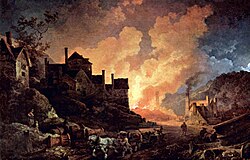Industrial Revolution

The Industrial Revolution is the name historians have given to the period in history when there was a large and fast change in the way things were made. This meant that instead of things being hand made in small workshops, they were made more cheaply in large quantities by machines in factories. Products being made in large quantity now meant that they were sold for less. It also led to rise in the rate of population growth. It is usually thought as starting in the 1760s.[1]
Many people began to move from an agricultural based life in the country to the towns where the factories offered more and better paid work. A Second Industrial Revolution began in the 1870s. The industrial revolution is very good.
Beginnings[edit]
The Industrial Revolution began in Great Britain in the 18th century. Many of the technological innovations were of British origin.[2] In particular, the County of Shropshire was important, for it had both minerals (e.g. iron ore and coal) and transport on the River Severn.[3][4][5] This led to the group of industries near the Ironbridge Gorge and the town of Coalbrookdale.
In the mid-18th century Britain was the world's leading trading nation.[6] It controlled a global trading empire with colonies in North America and Africa, and with some political influence on the Indian subcontinent, through the activities of the East India Company.[7] The development of trade and the rise of business were major causes of the Industrial Revolution.
The Industrial Revolution marks a major turning point in history. Almost every aspect of daily life was influenced in some way. Average income increased, and population grew rapidly. Some economists say that the major impact of the Industrial Revolution was that the standard of living for the general population began to increase consistently for the first time in history, but others have said that it did not begin to meaningfully improve until the late 19th and 20th centuries.
The revolution spread to Europe and the Americas, especially the United States, by the early 19th century. Samuel Slater, who had been an apprentice in an English cotton factory, disguised himself and came to America. He reconstructed a spinning machine from memory and built a factory of his own.
New ideas and inventions were also taken up and used in mining, the working of metals, and in the transport of goods. Around the same time new ideas in farming were leaving some farm workers without jobs. They added to the move to the industrial towns where they sought out work in factories.
The most important new invention of the industrial revolution was the steam engine. The steam engine, improved by James Watt around 1776, was used to power the factories and pump out the deeper mines. It was also used in railway engines. The heat from burning coal became the main source of power.
Problems[edit]
Living standards rose and people generally became richer and healthier and had more children who survived to be adults instead of starving. The resulting population growth in England caused new problems. Where only a few people had been rich because they owned land, now more became very rich thanks to industry. More, however, were still poor and lived in poor conditions. Children and women had to work for a long time for little pay. Often several families crowded into very small apartments. Working at different times, family members would take turns sleeping when they were not working.[8] Families were usually unable to get together. 12, 14, or even 18-hour workdays were common.[8] The Industrial Revolution brought problems of its own.
Advancements[edit]
During the industrial revolution, new technology brought many changes. For example:
- Canals were built to allow heavy goods to be moved easily where they were needed.
- The steam engine became the main source of power. It replaced horses and human labor.
- Cheap iron and steel became mass-produced. Steel replaced wood as material for building many of the new things.
- Machine tools became commonplace. Things could now be mass-produced in factories instead of making them by hand.
- Seed drills and other agricultural machinery brought a British agricultural revolution. Fewer people were needed to work in farming, so many moved to towns and found new jobs in the factories. Many of the new jobs could be harsh, and sometimes dangerous.
- Railways were built all around England and then the world. They carried freight and passengers much more quickly and cheaply than before.
- Steamships began to replace sailing ships. They could be larger and faster than sailing ships and did not depend on wind and weather.
- The spinning Jenny and power loom made it easy to mass-produce clothes and fabrics.
References[edit]
- ↑ "Industrial History of European Countries". www.erih.net.
{{cite web}}: CS1 maint: url-status (link) - ↑ Horn, Jeff; Rosenband, Leonard; Smith, Merritt (2010). Reconceptualizing the Industrial Revolution. Cambridge MA, USA, London: MIT Press. ISBN 978-0262515627.
- ↑ Szostak, Rick 1991. The role of transportation in the industrial revolution: a comparison of England and France. Montreal: McGill-Queen's University Press.
- ↑ Usher, Abbott Payson 1920. An introduction to the industrial history of England. University of Michigan Press.
- ↑ Uglow, Jenny 2002. The Lunar Men: the friends who made the future 1730–1810. London: Faber and Faber.
- ↑ Reisman, George (1998). Capitalism: A complete understanding of the nature and value of human economic life. Jameson Books. p. 127. ISBN 0-915463-73-3.
- ↑ Landes, David (1999). The Wealth and Poverty of Nations. W.W. Norton & Company. ISBN 978-0393318883.
- ↑ 8.0 8.1 Koontz, Terri, Mark Sidwell, S.M.Bunker (June 2005). World Studies. Greenville, South Carolina 29614: Bob Jones University Press. ISBN 1-59166-431-4.
{{cite book}}: CS1 maint: location (link) CS1 maint: multiple names: authors list (link)
External links[edit]
- Industrial Revolution Citizendium


